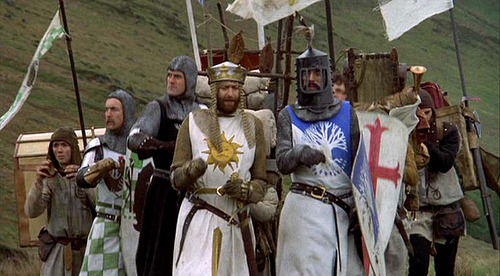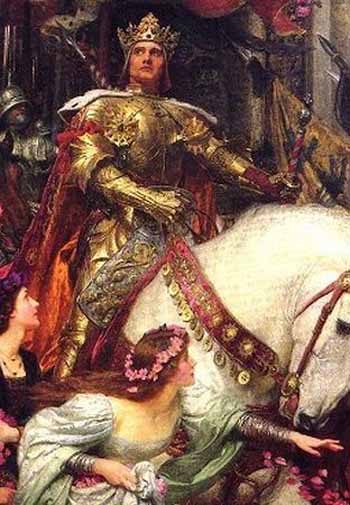 |
| Clive Owen as 'Arturius' in the 2004 film, King Arthur |
But where did these legends and stories come from? Was there ever a real "King Arthur"?
Great questions!
This is something I've wanted to study for years, and would love to spend many years of my future career as a Medievalist studying. So far, though, I've only read a book or two on the subject, so I can't claim to have conducted vast research, or that any of the following ideas are my own. (Some day, yes, but I'm not there yet.) Most of this stuff is based on an out-of-print book called King Arthur: The True Story, by Graham Phillips and Martin Keatman. I will simply relate my thoughts on what they extensively cover in this book, and as I know there's a lot of controversy in Arthurian Studies, please feel free to criticize me and comment (nicely)!
~
The story of King Arthur, as most of us are familiar with in modern times, goes something like this:
Long ago, barbarian hordes laid waste to the land of Britain and left the people without a king to eradicate the invaders. The rightful heir could only prove himself by freeing a magnificent sword from a great stone. Many tried, but none succeeded in moving the sword until Arthur, barely out of boyhood, sprung the sword from its ancient cast. The people exulted in Arthur and declared him king.
Arthur began his work to restore the nation by building the mighty fortress of Camelot as his capital, founding the order of the Knights of the Round Table, and exiling the evil barbarians who had overtaken the land.
King Arthur led the people to overcome a terrible plague and even set out to find the Holy Grail. But Arthur’s nephew, Modred, became jealous of his uncle’s success and led a rebellion that divided the kingdom. The conflict escalated until, in one final battle, Merlin, Arthur’s magician, defeated Modred.
But Arthur was fatally wounded in the same battle and, as his dying request, decreed that his magical sword, Excalibur, be cast back into the lake from which it came. Many say Arthur died on the Isle of Avalon while others hold that he merely sleeps, awaiting his return to power.
Quite different from what the legend has become, the historical King Arthur’s story (as proposed by Phillips and Keatman) is something like this:
So how did the story change so much from the truth to result in what we have today? When did the story make the switch from history to legend?The last of the Roman legions retreated from Britain in 410, leaving her inhabitants without the protection they had welcomed for three hundred years. The Britons divided into two rival groups, the Imperialists and Nationalists. The imperialists remained loyal to Rome, retained the Roman Catholic Church, and spoke Latin. The Nationalists returned to Celtic culture, spoke Gaelic, practiced Palagianism (a version of Christianity which the Roman Catholic Church declared to be heresy), and reverted to a tribal system of governance.
The divided Britons became easy prey for their neighbors, the Picts and Scots. In 449, a powerful British chieftain, Vortigern, invited Saxon mercenaries for protection. By 455, unrest among the Saxons grew into an ongoing war between the Saxons and the Britons.
In about 460, control of the powerful British kingdom of Gwynedd fell to the son of a Roman official, Ambrosious Aurelianus, who fought against the Saxons throughout his reign. A prince of the neighboring southern kingdom, Powys, Owain Ddantgwyn, rose alongside Ambrosious and proceeded to gain both kingdoms upon Ambrosious’ death.
In order to unite the Imperialists and Nationalists, Ddantgwyn took the battle name of Arthursus (a combination of the Gaelic arth and the Latin ursus, both meaning “bear”). This was later shortened to “Arthur.” He succeeded in uniting the Britons and led a campaign of twelve battles against the Anglo-Saxons, culminating in his victory in 493 at the battle of Badon Hill, which began a fifty-year ceasefire between the two nations.
After many prosperous years, Arthur’s nephew, Maglocunus, led a revolt, which ended in the battle at Camlann in 520. Arthur died in the battle and his kingdom was split; Maglocunus ruled Gwynedd and Arthur’s son, Cuneglasus, ruled Powys.
Geoffrey of Monmouth poses an excellent answer to these questions. He was a Welsh cleric who wrote the Historum Regum Britanniae (The History of the Kings of Britain) in the year 1135. The book was intended to be a true account of British history, not just a collection of legends and stories. It was also the first work to offer a detailed account of King Arthur’s life.
Monmouth’s Historum, when cross-referenced with other sources which are known to be reliable, appears to be more fiction than fact. For instance, Monmouth declares that the Britons were a nation founded by thousands of Trojans (refugees from Greece). He claims that the Saxons used an army of Africans to help them invade Britain and even denies that Rome ever conquered the island.
Monmouth wrote (and most later versions agree) that Arthur was born in Tintagel Castle, in Cornwall, which had not been built until after 1066 and though archaeologists speculate that the site of Tintagel may have held a fortress-residence of Dumnonian royalty in the early middle ages, it is unlikely that a non-Dumnonian ruler (Arthur) should have been born there. The historical Arthur was likely born in the Welsh kingdom of Powys, where he rose to power. Monmouth also wrote that Arthur conquered much of Europe –Norway, Denmark, and Gaul- whereas it seems that the historical Arthur conquered nothing, but was content to acquire the kingdom of Gwynedd and spend the rest of his rule keeping that and Powys prosperous and safe from the Saxons.
Wace, the Jersey Poet, added the round table in his version of the Arthurian story, written in 1155, and although a circular table hangs on the wall of Winchester Castle’s great hall, no implication of such a table exists in reference to the historical Arthur. In the 1190s, the Burgundian poet, Robert de Boron, added the most well known of the legendary Arthur’s exploits, the search for the Holy Grail. No such search occurred (at least, not until after 1190).
Even in their summaries, and ever more so as details are added, both stories are extraordinary. The mysterious boy king of lore who accomplished great deeds and reinvigorated a ravaged nation to be unimaginably powerful and prosperous again is difficult to make unappealing. The mighty battle prince who rose to unite a divided people, drove away their invaders, and advanced a flourishing and preeminent culture seems to be better than any storybook character.
So why was the story changed in the first place? What caused Monmouth to alter the facts in his Historum? The answer is very simple: politics.
Monmouth wrote that the purpose of the Historum was to give “a precedent for the dominions and ambitions of the Norman kings.” In a time when more than a title was required to rule a nation, the Normans needed a well known British ancestor to legitimize their claim to the English throne. By writing that Arthur conquered much of Europe (including Normandy), and therefore that Britons settled in Normandy, Monmouth gave the Normans their claim to rule.
By changing the story and unwittingly reducing it to mere story, Monmouth nearly ruined the true character of King Arthur. Though grand stories were produced, Monmouth effectively demonstrated that when writers (even with the best of intentions) allow politics to influence their work, the truth is distorted at best and forgotten altogether at worst.
 |
| King Arthur and his Knights in Monty Python and the Holy Grail |


No comments:
Post a Comment